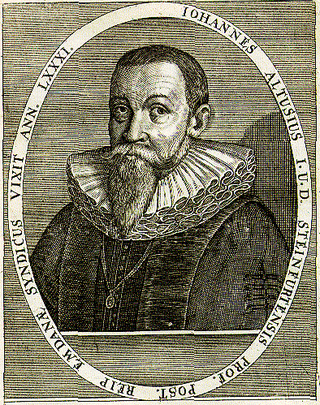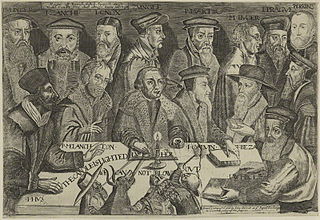Related Research Articles

Reformed Christianity, also called Calvinism, is a major branch of Protestantism that began during the sixteenth-century Protestant Reformation, a schism in the Western Church. Today, it is largely represented by the Continental, Presbyterian, and Congregational traditions, as well as parts of the Anglican and Baptist traditions.
Beeldenstorm in Dutch and Bildersturm in German are terms used for outbreaks of destruction of religious images that occurred in Europe in the 16th century, known in English as the Great Iconoclasm or Iconoclastic Fury and in French as the Furie iconoclaste. During these spates of iconoclasm, Catholic art and many forms of church fittings and decoration were destroyed in unofficial or mob actions by Calvinist Protestant crowds as part of the Protestant Reformation. Most of the destruction was of art in churches and public places.

Jean Bodin was a French jurist and political philosopher, member of the Parlement of Paris and professor of law in Toulouse. Bodin lived during the aftermath of the Protestant Reformation and wrote against the background of religious conflict in France. He seemed to be a nominal Catholic throughout his life but was critical of papal authority over governments and there was evidence he may have converted to Protestantism during his time in Geneva. Known for his theory of sovereignty, he favoured the strong central control of a national monarchy as an antidote to factional strife.
Whig history is an approach to historiography that presents history as a journey from an oppressive and benighted past to a "glorious present". The present described is generally one with modern forms of liberal democracy and constitutional monarchy: it was originally a satirical term for the patriotic grand narratives praising Britain's adoption of constitutional monarchy and the historical development of the Westminster system. The term has also been applied widely in historical disciplines outside of British history to describe "any subjection of history to what is essentially a teleological view of the historical process". When the term is used in contexts other than British history, "whig history" (lowercase) is preferred.
Via media is a Latin phrase meaning "the middle road" or the "way between two extremes".
The Monarchomachs were originally French Huguenot theorists who opposed monarchy at the end of the 16th century, known in particular for having theoretically justified tyrannicide. The term was originally a pejorative word coined in 1600 by the Scottish royalist and Catholic William Barclay (1548–1608) from the Greek μόναρχος and μάχομαι, meaning "those who fight against monarchs" or "anti-monarchists".
John Ponet, sometimes spelled John Poynet, was an English Protestant churchman and controversial writer, the bishop of Winchester and Marian exile. He is now best known as a resistance theorist who made a sustained attack on the divine right of kings.

Johannes Althusius was a German-French jurist and Calvinist political philosopher.
Irenicism in Christian theology refers to attempts to unify Christian apologetical systems by using reason as an essential attribute. The word is derived from the Greek word ειρήνη (eirene) meaning peace. It is a concept related to a communal theology and opposed to committed differences, which can cause unavoidable tension or friction, and is rooted in the ideals of pacifism. Those who affiliate themselves with irenicism identify the importance of unity in the Christian Church and declare the common bond of all Christians under Christ.
The Merton thesis is an argument about the nature of early experimental science proposed by Robert K. Merton. Similar to Max Weber's famous claim on the link between Protestant work ethic and the capitalist economy, Merton argued for a similar positive correlation between the rise of Protestant Pietism and early experimental science. The Merton thesis has resulted in continuous debates.

Reformed Christianity originated with the Reformation in Switzerland when Huldrych Zwingli began preaching what would become the first form of the Reformed doctrine in Zürich in 1519.
John Dury was a Scottish Calvinist minister and an intellectual of the English Civil War period. He made efforts to re-unite the Calvinist and Lutheran wings of Protestantism, hoping to succeed when he moved to Kassel in 1661, but he did not accomplish this. He was also a preacher, pamphleteer, and writer.

Protestantism is a branch of Christianity that emphasizes justification by God through faith alone, the teaching that salvation comes by unmerited divine grace, the priesthood of all believers, and the Bible as the sole infallible source of authority for Christian faith and practice. The five solae summarize the basic theological beliefs of mainstream Protestantism.
Edmond Richer was a French theologian known for several works advocating the Gallican theory, that the pope's power was limited by authority of bishops, and by temporal governments. He was born in Chaource.
Henning Arnisaeus (Arniseus) (1570–1636) was a German physician and moral philosopher. He is now known for his writings on political theory.

Arminianism was a controversial theological position within the Church of England particularly evident in the second quarter of the 17th century. A key element was the rejection of predestination. The Puritans fought against Arminianism, and King James I of England opposed it before, during, and after the Synod of Dort, 1618–1619, where the English delegates participated in formulating the Calvinist Canons of Dort, but his son Charles I, favoured it, leading to deep political battles. The Methodists, who espoused a variant of the school of thought called Wesleyan–Arminian theology, branched off the Church of England in the 18th century.
Ordinum Hollandiae ac Westfrisiae pietas is a 1613 book on church polity by Hugo Grotius. It was the first publication of Grotius, a prominent jurist and Remonstrant, concerned with the Calvinist-Arminian debate and its ramifications, a major factor in the politics of the Netherlands in the 1610s. The Ordinum pietas, as it is known for short, gave a commentary on the Five Articles of Remonstrance of 1610 that were the legacy of the theological views of Jacobus Arminius, who died in 1609.

The Oath of Allegiance of 1606 was an oath requiring English Catholics to swear allegiance to James I over the Pope. It was adopted by Parliament the year after the Gunpowder Plot of 1605. The oath was proclaimed law on 22 June 1606, it was also called the Oath of Obedience. Whatever effect it had on the loyalty of his subjects, it caused an international controversy lasting a decade and more.
Jacques Leschassier was a French jurist and magistrate, known for his erudition and Gallican views.

The doctrine of the lesser magistrate is a concept in Protestant thought. A lesser magistrate is a ruler such as a prince who is under a greater ruler such as an emperor. The doctrine of the lesser magistrate is a legal system explaining the exact circumstances in which a lesser magistrate has both the right and the responsibility to resist the greater ruler.
References
- ↑ Arthur P. Monahan, The Circle of Rights Expands: Modern political thought after the Reformation, 1521 (Luther) to 1762 (Rousseau) (2007), pp. 55–6; Google Books.
- ↑ J. H. Burns (editor), The Cambridge History of Political Thought, 1450-1700, p. 200; Google Books.
- ↑ (in German)Bekenntnis Unterricht und Vermanung.
- ↑ John R. Stumme and Robert W. Tuttle, Church & State: Lutheran perspectives (2003), pp. 41–2; Google Books.
- ↑ R. B. Wernham (editor), The New Cambridge Modern History: The Counter-Reformation and price revolution, 1559-1610 (1968), p. 98; Google Books.
- ↑ John William Allen, A History of Political Thought in the Sixteenth Century (1977), p. 106.
- ↑ Burns, p. 194; Google Books.
- ↑ Patrick Collinson, Elizabethans (2003), p. 45; Google Books.
- ↑ Wiep van Bunge et al. (editors), The Dictionary of Seventeenth and Eighteenth-Century Dutch Philosophers (2003), Thoemmes Press (two volumes), article Althusius, Johannes, p. 11–18.
- ↑ Deborah Baumgold, Contract Theory in Historical Context: essays on Grotius, Hobbes, and Locke (2010), p. 29–30; Google Books.
- ↑ Burns, p. 233; Google Books.
- ↑ Burns, p. 231; Google Books.
- ↑ Burns, p. 232; Google Books.
- ↑ Edward Vallance, Revolutionary England and the National Covenant: state oaths, Protestantism, and the political nation, 1553-1682 (2005), p. 12; Google Books.
- ↑ Robert Oresko, G. C. Gibbs, Hamish M. Scott, Royal and Republican Sovereignty in Early Modern Europe: essays in memory of Ragnhild Hatton (1997), p. 141; Google Books.
- ↑ Anthony Milton, Catholic and Reformed: The Roman and Protestant Churches in English Protestant Thought, 1600-1640 (2002), p. 517; Google Books.
- ↑ W. B. Patterson, King James VI and I and the Reunion of Christendom (2000), pp. 23–4 and pp. 67–8.
- ↑ Lisa Ferraro Parmelee, Good Newes from Fraunce: French anti-league propaganda in late Elizabethan England (1996), pp. 88–9; Google Books.
- ↑ Francis Oakley, Politics and Eternity: studies in the history of medieval and early-modern political thought (1999), p. 166; Google Books.
- 1 2 Glenn Burgess, The Politics of the Ancient Constitution (1992), p. 181, p. 95, and p. 171.
- ↑ p. 89; Google Books.
- ↑ Russell, Conrad. "Pym, John". Oxford Dictionary of National Biography (online ed.). Oxford University Press. doi:10.1093/ref:odnb/22926.(Subscription or UK public library membership required.)
- ↑ Conrad Russell, The Causes of the English Civil War (1990), p. 23.
- ↑ Nicholas T. Phillipson, Quentin Skinner, Political Discourse in Early Modern Britain (1993), p. 250; Google Books.
- ↑ R. O. Bucholz, Newton Key, Early Modern England 1485-1714: a narrative history (2009), p. 298; Google Books.
- ↑ Michael Brydon, The Evolving Reputation of Richard Hooker: An Examination of Responses, 1600–1714 (2006), pp. 188–90.